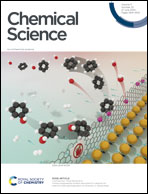Approaching the voltage and energy density limits of potassium–selenium battery chemistry in a concentrated ether-based electrolyte†
Abstract
Potassium–selenium (K–Se) batteries offer fairly high theoretical voltage (∼1.88 V) and energy density (∼1275 W h kgSe−1). However, in practice, their operation voltage is so far limited to ∼1.4 V, resulting in insufficient energy utilization and mechanistic understanding. Here, it is demonstrated for the first time that K–Se batteries operating in concentrated ether-based electrolytes follow distinctive reaction pathways involving reversible stepwise conversion reactions from Se to K2Sex (x = 5, 3, 2, 1). The presence of redox intermediates K2Se5 at ∼2.3 V and K2Se3 at ∼2.1 V, in contrast with previous reports, enables record-high average discharge plateau voltage (1.85 V) and energy density (998 W h kgSe−1 or 502 W h kgK2Se−1), both approaching the theoretical limits and surpassing those of previously reported Na/K/Al–Se batteries. Moreover, experimental analysis and first-principles calculations reveal that the effective suppression of detrimental polyselenide dissolution/shuttling in concentrated electrolytes, together with high electron conductibility of Se/K2Sex, enables fast reaction kinetics, efficient utilization of Se, and long-term cyclability of up to 350 cycles, which are impracticable in either K–S counterparts or K–Se batteries with low/moderate-concentration electrolytes. This work may pave the way for mechanistic understanding and full energy utilization of K–Se battery chemistry.



 Please wait while we load your content...
Please wait while we load your content...